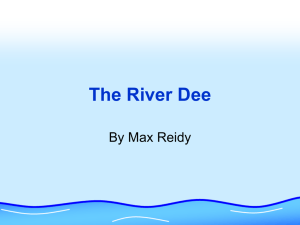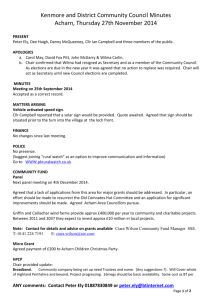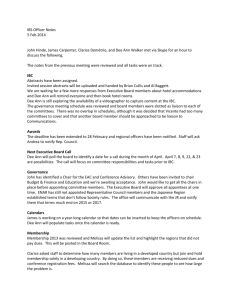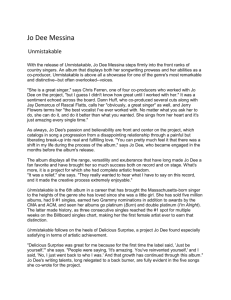Dee the Mammoth Video- Lesson (Word doc)
advertisement
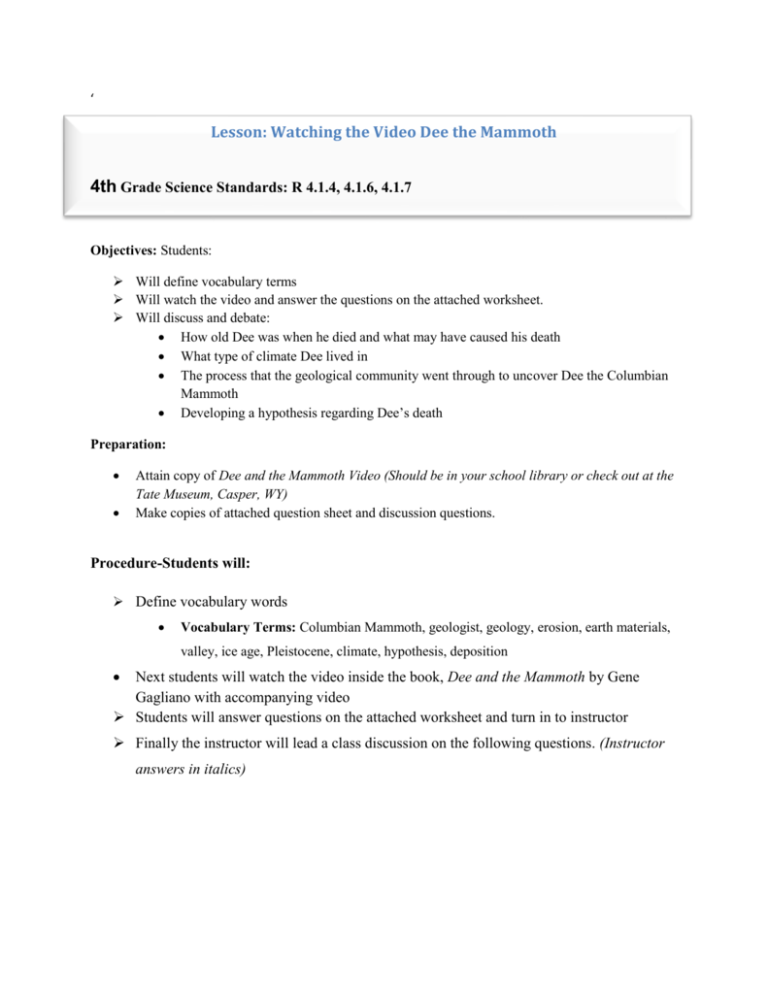
‘ Lesson: Watching the Video Dee the Mammoth 4th Grade Science Standards: R 4.1.4, 4.1.6, 4.1.7 Objectives: Students: Will define vocabulary terms Will watch the video and answer the questions on the attached worksheet. Will discuss and debate: How old Dee was when he died and what may have caused his death What type of climate Dee lived in The process that the geological community went through to uncover Dee the Columbian Mammoth Developing a hypothesis regarding Dee’s death Preparation: Attain copy of Dee and the Mammoth Video (Should be in your school library or check out at the Tate Museum, Casper, WY) Make copies of attached question sheet and discussion questions. Procedure-Students will: Define vocabulary words Vocabulary Terms: Columbian Mammoth, geologist, geology, erosion, earth materials, valley, ice age, Pleistocene, climate, hypothesis, deposition Next students will watch the video inside the book, Dee and the Mammoth by Gene Gagliano with accompanying video Students will answer questions on the attached worksheet and turn in to instructor Finally the instructor will lead a class discussion on the following questions. (Instructor answers in italics) Background information & Classroom Questions 1. Scientists believe that Dee died in an arroyo which has changed over time so that Dee was found on a hilltop. Why would that land feature have changed? Describe the process. (Land changes across time due to erosion. The arroyo changed into a hill due to windblown deposition) 2. Why are more mammoth fossils found in the eastern plains than Wyoming? (Climate change- more wet so more grass.) 3. How would scientists develop hypotheses regarding Dee’s death? (Geologists and paleontologists would look at Dee’s bones. For example: Tusk rings determine age, teeth erosion demonstrates the loss of chewing ability, bony ridges on vertebrae determines arthritis, thus difficulty moving with seasonal climates.) Online Resources: http://www.caspercollege.edu/tate Evaluation: Students complete question sheet correctly and engage in group discussions regarding Dee the mammoth. Enrichment: Take students on field trip to the Casper College Tate Museum and see the Dee permanent exhibit. Dee the Mammoth Video Worksheet Name: While watching the video, answer the following questions. 1. What type of climate would Dee have lived in? How long ago? 2. Roughly how many volunteers were involved in digging up Dee? 3. How many pounds of grass a day would Dee have eaten? 4. Is Dee a male of female? 5. Roughly how old was Dee when she/he died? 6. What do geologists think was Dee’s cause of death? 7. What season did Dee probably die in based on the geologist’s hypothesis? 8. What was the first bone uncovered by the bulldozer operator? 9. What animal was eating the skull of Dee? 10. According to the geologist’s hypothesis, why was Dee’s skull found so far from the body? 11. What type of land feature did Dee die in? 12. Where can you see Dee the Columbian mammoth? Dee Video Discussion Questions: (In red - succinct answer for the instructor) 1. Dee died in a valley and Dee was found on a hilltop. What would have contributed to the land changing over time? Describe the process. ( Land changing across time: Windblown deposition) 2. Why are more mammoth fossils found in the eastern plains than Wyoming? (Climate changemore wet thus more grass) 3. The process that the geological community went through to uncover Dee the Columbian Mammoth (Contained in video) 4. How would scientists develop hypotheses regarding Dee’s death? (Geologist and Paleontologists would look at Dee’s bones: Tusk ring growth determines age, teeth erosion demonstrates loss of chewing capacity, and bony ridges determine arthritis difficulty to move to a more seasonal climate)

